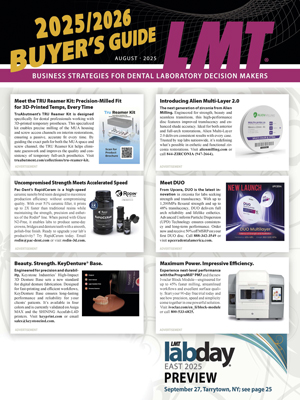Get your Lab out in front of the competition
There two solutions to diminishing profit: Reduce costs through small Lean productivity improvements (will require some small expense); and combine that with increased efforts and spending on sales and promotion. Yes, this counter-intuitive! All of our experience and training says REDUCE cost, not increase it. Here are a few ideas and tactics to help you move forward.
Get your leadership on the street
If anything, this is the time to increase your effort and expenditures on sales and promotion, and assign as many qualified people as possible to talk to and meet with customers and prospective customers. The name of the game is "feet on the street." The owner/CEO and other key people can be particularly important in this initiative. At the same time, you want to redouble promotional activities, especially communications to potential new accounts.
As always, however, our best opportunities for additional business are often with existing customers. Now, more than ever, you want to be a hero to every customer. This means being dependable: promptly responding to dentist inquiries, delivering cases on time, every time, and assuring perfect quality. Sound familiar? These goals are completely consistent with those you pursue through a Lean/continuous improvement program. If you have a Lean initiative in place, focus or re-focus on the needs of your customers as they navigate the same economic hardships that you face. If you have not begun to employ Lean principles, now is the time.
Another important approach to increasing your revenue is to "expand the pond" by offering new products or services to your existing customers, or sell existing products and services to new customers/markets. This requires flexible and creative thinking and a willingness to grasp new opportunities. Areas of new business that were of little interest when you were operating at or near capacity may now be a key to propping up sales in the short-term and fueling our longer-term growth.
Increase productivity
Productivity is defined as output per unit of input. Improved productivity, in simple terms, is doing more with less. The philosophy, principles and tools of Lean all specifically aim at this goal. While some Lean projects (e.g., major lab renovations/reorganizations) are capital intensive and may have to wait, hundreds of other small improvements can be supported with nominal expenditures. This level of Lean implementation should not be interrupted. Also, be certain that Lean principals apply to both the Lab and the office. White-collar productivity must also improve. Above all, keep your Lean initiative alive! With respect to your Lean capabilities, promote them heavily. Point out to customers or prospects those ways in which you can tie in to their Lean efforts through quick-response programs, on-site training for impressions, office management, communications, new technologies and other programs.
Workforce Capability
You want to make sure you have the right people on the bus and in the right seats. If necessary, get the wrong people off the bus. If you have the prerogative, you obviously want to first dismiss those employees with a history of performance issues. For those employees on the bus, building the business means building a better wider set of skills to increase flexibility. Beware..you may lose some key employees if you fail to communicate clearly and often about the state of the business, your basic intent and your plans to grow the business.
Managing Cash
With respect to managing cash, you will need to undergo a behavioral change. With a firm commitment to shoring up sales and revenue and driving productivity improvement throughout the company, you may still have to reduce the break-even point for the business. This involves a careful look at all of the fixed and semi-variable costs.
Fixed costs often are actually fixed. There may be little you can do to reduce or eliminate them. Nevertheless, each line item should be scrutinized for opportunities to reduce the outflow of cash. Can some salary costs be deferred? Can you vacate some rented space? Can your debt be restructured to reduce the payments in the near term? What could be done to reduce or defer the cost of employee benefits?
All semi-variable costs should be evaluated. Review all discretionary expenses including shipping (inbound and outbound), raw materials, and building maintenance, and overtime (except where absolutely required to satisfy customers). Productivity concepts will drive a reduction in Non-Value added tasks, thereby increasing productivity and eliminating the need for excessive overtime. Look at travel; can you accomplish the same thing with video or teleconferencing? Lean helps you to work smarter, not harder, so maybe you can defer fixed asset (capital) expenses until the next quarter or next year when your business increases. Say no to all capital projects and see which ones resurface with solid economic justification in support of the specific project. These are typically the ones worth considering.
Diligently manage the collections process. Offer cash discounts for payment in 15 days or less. If the payment date passes by, follow-up to see when you can expect payment. Identify doubtful accounts early and use aggressive tactics to collect. You may need to "beef up" this effort by temporarily assigning someone from an unrelated area to assist in the collection efforts. Maintaining your cash position is critical to growth going forward.
Keep Investing
Even when cash is short, investing in the future is important. Some investments are needed to maintain momentum, to ensure that the company continues to move in the desired direction. Maintaining a Lean initiative is one very important example. Others may include new product or process development programs, training, supplier development, and marketing efforts. Remember the goal is to get in front of the competition.
Get a Plan in place
Successfully guiding a company through a growth scenario is among the greatest challenges facing any business leader. It demands the highest level of commitment to customers and other stakeholders in the business. By using these basic “tried and true” tactics, you can get your lab out in front of the competition.











